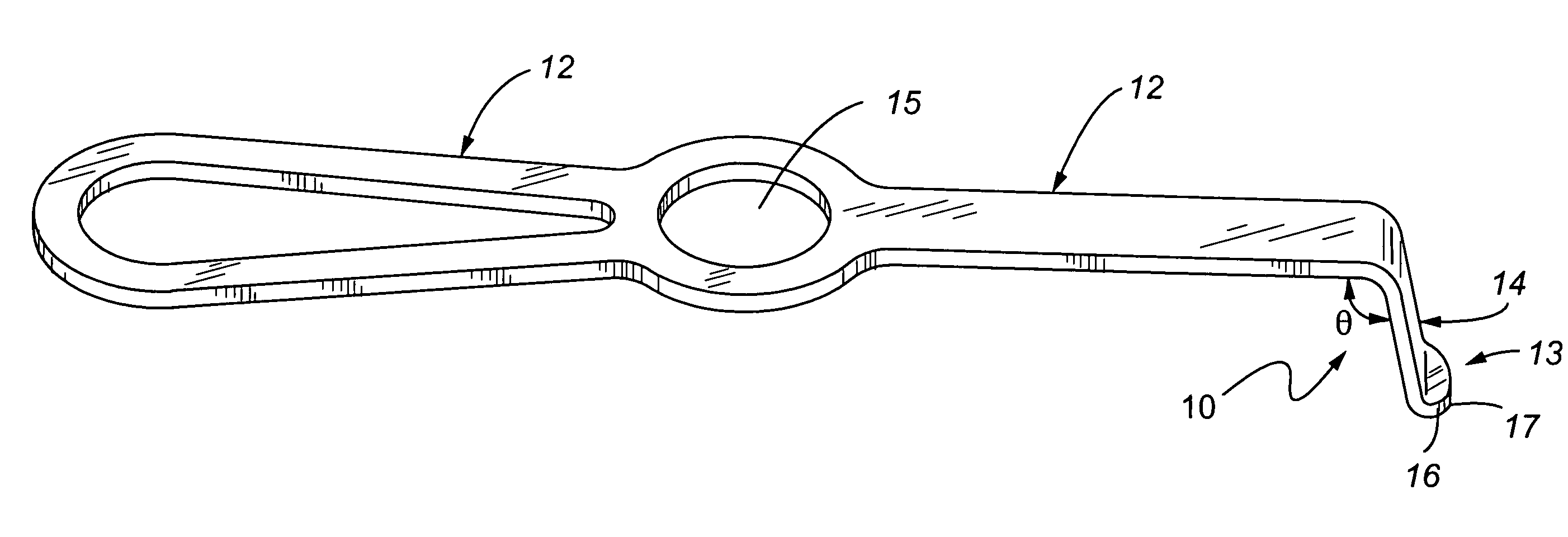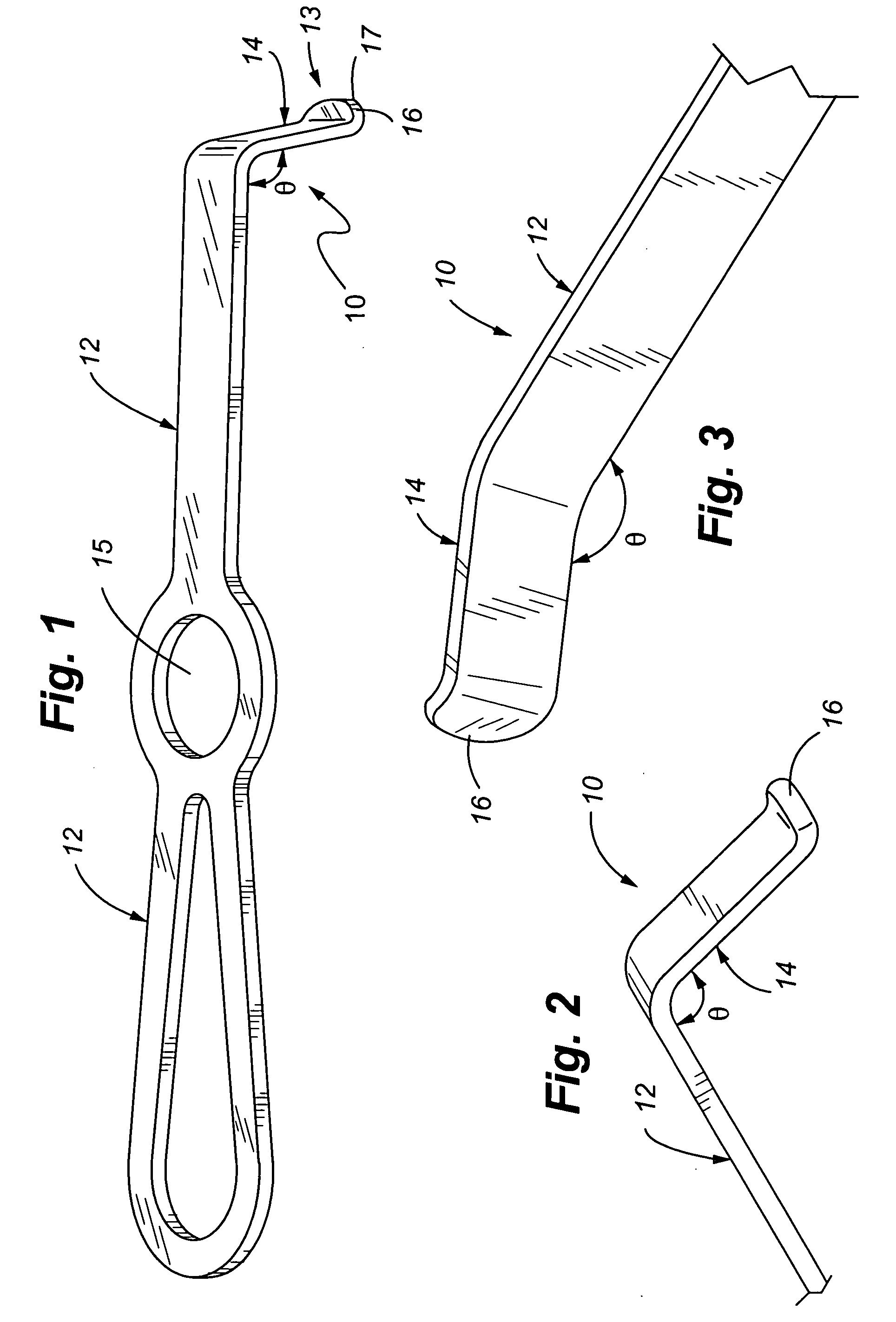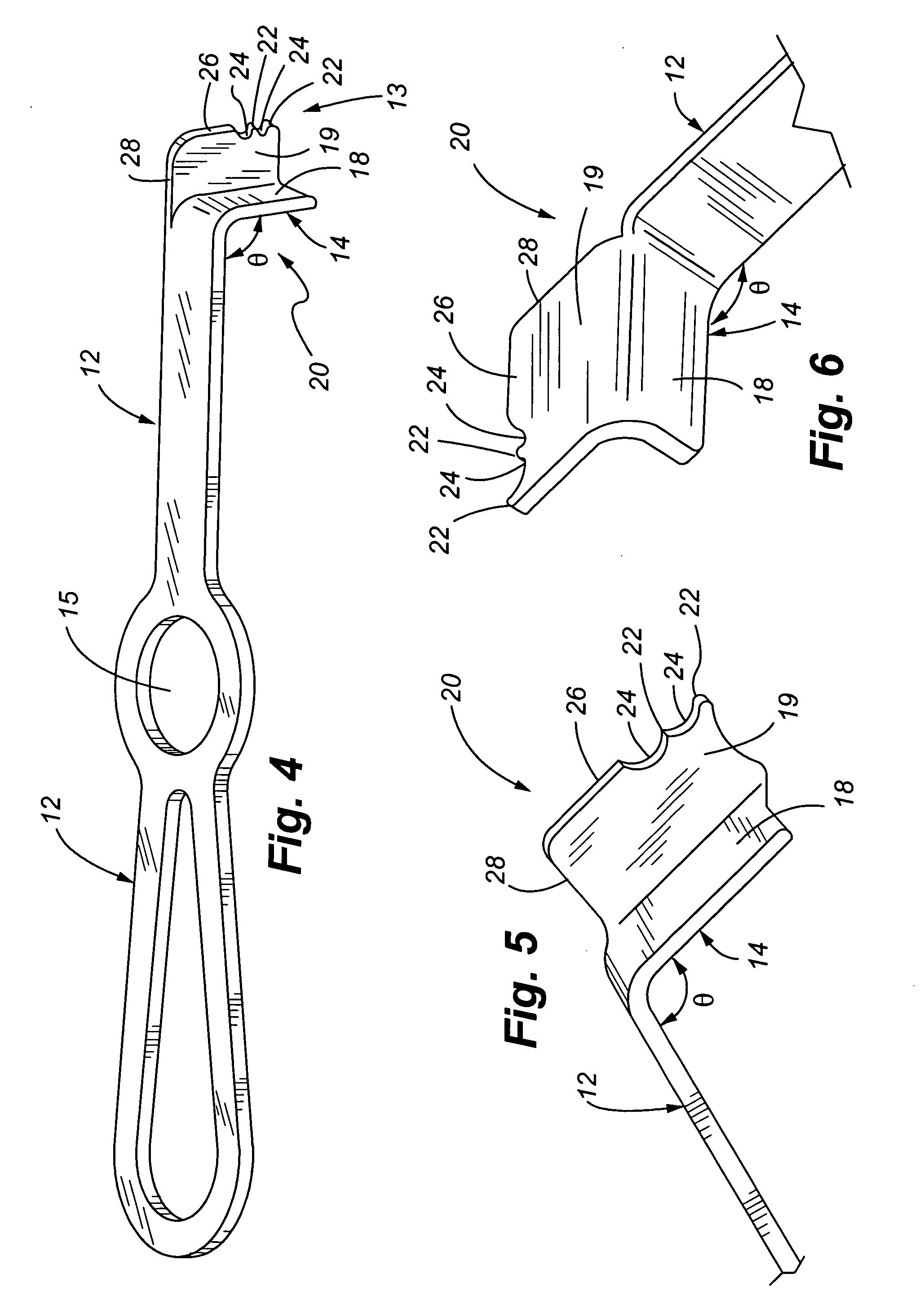[0007] One method of retraction is to use a
muscle splitting or intermuscular approach to access the spine for fixation and for interbody fusion or
dynamic fixation. An angled retractor offers the
advantage of being able to be manipulated by a surgeon to engage the
implant construct and retract the muscles medially to provide a window of access medial to the
implant construct with secure fixation against the
implant. This device enables a surgeon to access the pedicle for
screw placement.
[0008] Preferred embodiments of the present invention allow a surgeon to minimize the
exposure needed for
surgery, thereby minimizing the necessary retraction, and also allows the device to be used with a guide wire or
drill with a minimum approach. The retractors of the present invention can be made in a right and left configuration, and the blade is typically used in lengths
ranging from about 25 to 90 mm from its proximal end to its distal end. In addition, the blade is preferably angled relative to the attached
handle at an angle of about 90 degrees or greater, and more preferably, at an angle of about 115 degrees to correspond to the typically needed trajectory for
screw placement into the
lumbar spine. In addition, a separate aspect of the present invention is a blade having a width of about 12 to 16 mm to provide an appropriate window for a typical polyaxial screw and with one or a plurality of points to engage and stabilize the retractor.
[0009] Thus, in one embodiment of the present invention, a tissue retractor for use in surgery of a spine is provided, wherein the retractor includes a
handle and a blade connected to the
handle at an intersection. Preferably, the handle forms an angle with the blade of between about 90 and 135 degrees, and more preferably, the handle forms an angle with the blade of about 115 degrees. The blade includes a first face and a second face positioned transverse to the first face, and more preferably, the first face is substantially perpendicular to the second face with a quarter-rounded bend interconnecting the first face to the second face. In accordance with embodiments of the present invention, the second face has an upper proximal edge spaced apart from the intersection, and the second face also preferably has a variable width, with a first larger width at a location positioned proximally of a second narrower width at the distal end of the second face. In accordance with embodiments of the present invention, the distal end of the second face includes at least one co-planar forward projecting tooth for laterally engaging an articular complex of a
vertebra of the spine. In addition, the first and second faces of the blade preferably include a partially rounded tip at the distal end of the blade. The first face optionally includes a terminal indentation or a distal tooth at the distal end of the blade, wherein the terminal indentation or distal tooth are adapted to engage a transverse process of the
vertebra. The retractor optionally further includes a third face located transverse to the first face and opposite the second face, wherein the first face is substantially perpendicular to the third face with a quarter-rounded bend interconnecting the first face to the third face. In accordance with embodiments of the present invention, the first, second and third faces preferably form a U-shape, with the third face substantially parallel to the second face. Similar to the second face, the third face preferably includes at least one co-planar forward projecting tooth, and more preferably, a plurality of co-planar forward projecting teeth. In one example of this embodiment, the third face further includes an upper proximal edge located distally of the upper proximal edge of the second face. The first face of the blade may also have a variable width, preferably including a first larger width at a location positioned proximally of a second narrower width at a distal end of the first face. The retractor preferably includes a partially rounded smooth outer blade surface that allows tissue to easily slide along the outer surface of the retractor as the retractor is inserted or withdrawn from a
surgical site. Finally, the retractor may optionally include a tool groove along its first face.
[0010] In accordance with embodiments of the present invention, a retractor is provide wherein the retractor includes a handle and a blade connected to the handle, the blade including a first face and a second face positioned substantially perpendicular to the first face. In accordance with embodiments of the present invention, the second face includes at least one tooth for laterally engaging an articular process of a vertebra of the spine. The first face has a tapered width with a first larger width at a location positioned proximally of a second narrower width at a distal end of the first face, and the second face also has a tapered width with a larger width positioned proximally of a narrower width at a distal end of the second face. The retractor can be made in a left or a right hand configuration to accommodate approaching the spine from either side. When used in
lumbar surgery, the blade preferably has a length between about 25 to 90 and the handle forms an angle with the blade of between about 90 and 135 degrees, and more preferably, the handle forms an angle with the blade of about 115 degrees. The blade preferably includes a curved transition between the first face and the second face. The curved transition can comprise a constant
radius curve, or it can comprise a tapered conic section consistent with the taper of the first face and the taper of the second face. The retractor optionally includes a third face located transverse to the first face, wherein the first face is substantially perpendicular to the third face, and wherein the first, second, and third faces form a U-shaped interior surface. Similar to the second face, the third face preferably includes at least one co-planar forward projecting tooth, and more preferably, a plurality of co-planar forward projecting teeth. The retractor also preferably includes a partially rounded smooth outer blade surface that allows tissue to easily slide along the outer surface of the retractor as the retractor is inserted into or removed from a
surgical site. Finally, the retractor may optionally include a tool groove along its first face.
 Login to View More
Login to View More  Login to View More
Login to View More 


